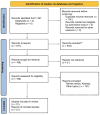Application of Artificial Intelligence in Pancreatic Cyst Management: A Systematic Review
- PMID: 40805252
- PMCID: PMC12346778
- DOI: 10.3390/cancers17152558
Application of Artificial Intelligence in Pancreatic Cyst Management: A Systematic Review
Abstract
Background: Pancreatic cystic lesions (PCLs), including intraductal papillary mucinous neoplasms (IPMNs) and mucinous cystic neoplasms (MCNs), pose a diagnostic challenge due to their variable malignant potential. Current guidelines, such as Fukuoka and American Gastroenterological Association (AGA), have moderate predictive accuracy and may lead to overtreatment or missed malignancies. Artificial intelligence (AI), incorporating machine learning (ML) and deep learning (DL), offers the potential to improve risk stratification, diagnosis, and management of PCLs by integrating clinical, radiological, and molecular data. This is the first systematic review to evaluate the application, performance, and clinical utility of AI models in the diagnosis, classification, prognosis, and management of pancreatic cysts.
Methods: A systematic review was conducted in accordance with PRISMA guidelines and registered on PROSPERO (CRD420251008593). Databases searched included PubMed, EMBASE, Scopus, and Cochrane Library up to March 2025. The inclusion criteria encompassed original studies employing AI, ML, or DL in human subjects with pancreatic cysts, evaluating diagnostic, classification, or prognostic outcomes. Data were extracted on the study design, imaging modality, model type, sample size, performance metrics (accuracy, sensitivity, specificity, and area under the curve (AUC)), and validation methods. Study quality and bias were assessed using the PROBAST and adherence to TRIPOD reporting guidelines.
Results: From 847 records, 31 studies met the inclusion criteria. Most were retrospective observational (n = 27, 87%) and focused on preoperative diagnostic applications (n = 30, 97%), with only one addressing prognosis. Imaging modalities included Computed Tomography (CT) (48%), endoscopic ultrasound (EUS) (26%), and Magnetic Resonance Imaging (MRI) (9.7%). Neural networks, particularly convolutional neural networks (CNNs), were the most common AI models (n = 16), followed by logistic regression (n = 4) and support vector machines (n = 3). The median reported AUC across studies was 0.912, with 55% of models achieving AUC ≥ 0.80. The models outperformed clinicians or existing guidelines in 11 studies. IPMN stratification and subtype classification were common focuses, with CNN-based EUS models achieving accuracies of up to 99.6%. Only 10 studies (32%) performed external validation. The risk of bias was high in 93.5% of studies, and TRIPOD adherence averaged 48%.
Conclusions: AI demonstrates strong potential in improving the diagnosis and risk stratification of pancreatic cysts, with several models outperforming current clinical guidelines and human readers. However, widespread clinical adoption is hindered by high risk of bias, lack of external validation, and limited interpretability of complex models. Future work should prioritise multicentre prospective studies, standardised model reporting, and development of interpretable, externally validated tools to support clinical integration.
Keywords: IPMN; MCN; artificial intelligence; benign; diagnosis; machine learning; malignant; pancreatic cyst; prognosis.
Conflict of interest statement
The authors declare no conflicts of interest.
Figures





References
-
- Zhang H., Qie Y. Applying Deep Learning to Medical Imaging: A Review. Appl. Sci. 2023;13:10521. doi: 10.3390/app131810521. - DOI
-
- Javaheri H., Ghamarnejad O., Widyaningsih R., Bade R., Lukowicz P., Karolus J., Stavrou G.A. Enhancing Perioperative Outcomes of Pancreatic Surgery with Wearable Augmented Reality Assistance System: A Matched-Pair Analysis. Ann. Surg. Open. 2024;5:e516. doi: 10.1097/AS9.0000000000000516. - DOI - PMC - PubMed
Publication types
LinkOut - more resources
Full Text Sources
Miscellaneous

